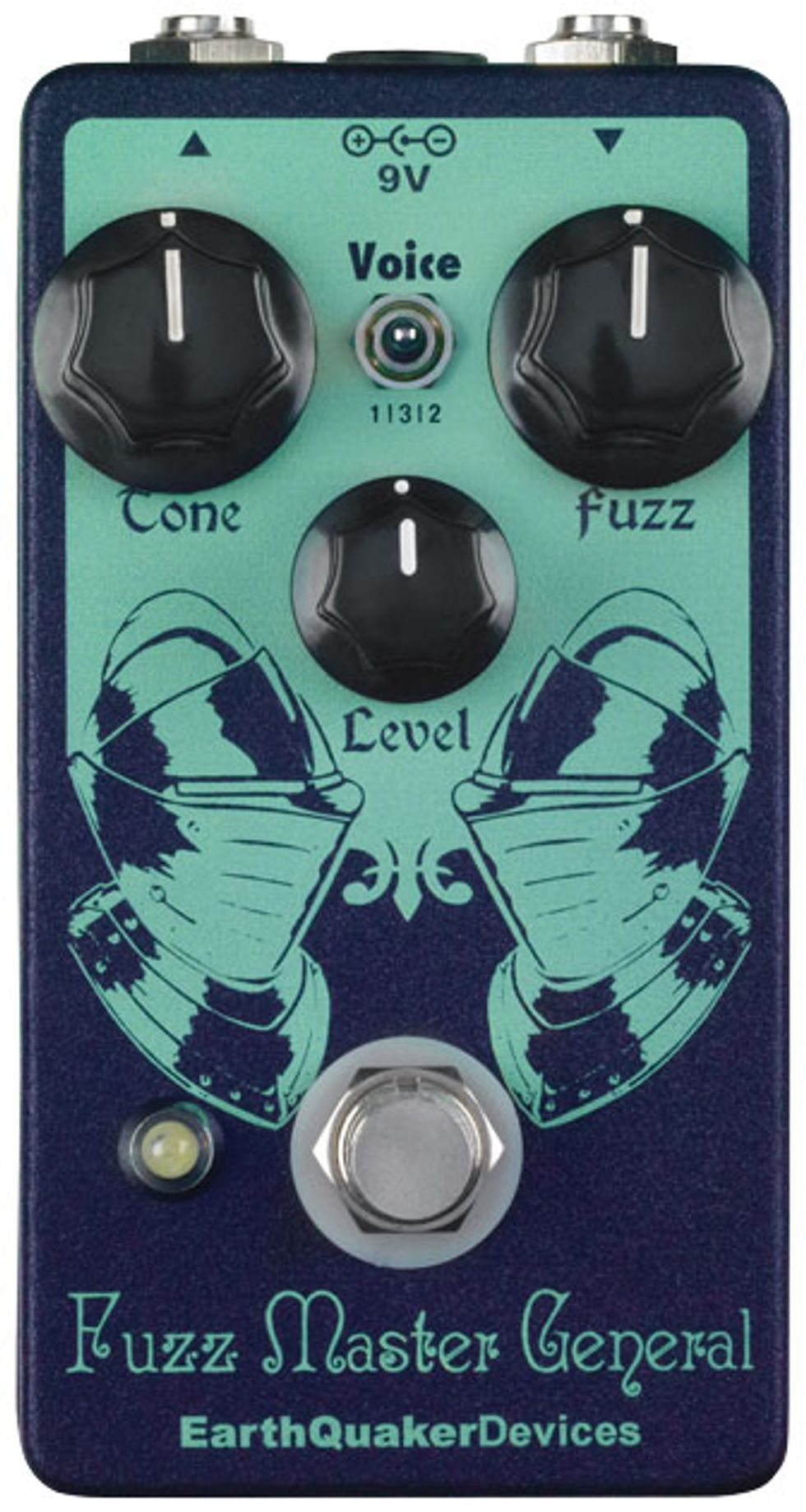Univox’s Shin-Ei-designed Super-Fuzz is rightly regarded as a classic, though few guitarists would claim it’s as versatile as a Fuzz Face, Tone Bender, or Big Muff. The Super-Fuzz’s high-octave jabs and big, compressed fuzz may have made the Who’s Live at Leeds magical, but in reality it can be a beast to control.
EarthQuaker Devices’ new take on the Super-Fuzz, the Fuzz Master General, isn’t a lot easier to manage, but its ability to switch between germanium, silicon, or no clipping diodes at all, as well as its variable tone knob (which takes the place of the Super-Fuzz’s two-position tone selector) make it a much more varied and versatile little monster.
Detonation Switch
You might expect the Fuzz Master General’s circuit to be a busy affair, given its multi-octave complexity and diode-switching functionality. It’s not. The board takes up less than half of the interior space, leaving plenty of room for a 9V battery.
The best way to explore the General’s multi-faceted personality is to move through the three diode-clipping options. Voice one is germanium-diode mode, which is most like a vintage Super-Fuzz. Like most Super-Fuzz-type pedals, the General’s intrinsically high compression means you’ll probably have to keep the fuzz and level wide open to be heard over a stampeding four- or five-piece rock band. (Guitarists in power trios or duos will have a lot more leeway in this respect—it’s little wonder Pete Townshend and Dan Auerbach both use Super-Fuzzes.) Throwing all the controls wide open—that is, fuzz and level at maximum, with tone at a brighter setting—is not without peril, though. The Fuzz Master General can become a piercing feedback demon if you’re not careful. If it does, take advantage of the variable tone knob, which scoops the 1k range.
Ratings
Pros:
Offers more-versatile versions of the yummy Super-Fuzz voice. No-clipping mode is loud enough to be heard above Deep Purple in its prime. Variable tone knob is far more useful than the Univox 1kHz scoop.
Cons:
Lacks some of a good Super-Fuzz’s buzzing wooliness.
Tones:
Ease of Use:
Build/Design:
Value:
Street:
$185
EarthQuaker Devices Fuzz Master General
earthquakerdevices.com
Germanium mode also offers more control from your guitar’s volume knob. It’s hard to say whether greater sensitivity to volume attenuation or a smoother distortion curve adds to the responsiveness. But whatever the reason, the softer germanium clipping gives you more power to tame the General’s unruly side.
Octave Shape-Shifting
One cool thing about guitar-volume attenuation with both the silicon- and germanium-clipping modes is how the fuzz characteristics can shift. Lower guitar volume highlights the almost ring-modulated quality of the octave fuzz—especially on single notes. One of my favorite maneuvers was to move from an arpeggiated triad to a power chord in the course of a phrase. The triad’s single notes took on a metallic, almost sitar-like resonance, while the power chords sounded tight, punchy, and huge—a very cool contrast. The tone knob is especially useful on the germanium side, not least because you can tame the pedal’s penchant for feedback at the brighter settings. The ability to move through a variable EQ filter range rather than only select a 1kHz filter (as on the old Super-Fuzz) really enhances the EarthQuaker’s flexibility.
Paradoxically, the General’s silicon side—with its harder clipping characteristics and greater compression—can feel more forgiving, at least where picking dynamics are concerned. Though it’s worth noting that, in any mode, all the Fuzz Master’s clipped-octave content doesn’t easily forgive sloppy picking. Complex chords can sound messy too, but the octave presence makes I-V power chords and simple note clusters like double stops and minor thirds sound huge.
The General’s third voice is destructively massive. There’s no clipping in this circuit, which means there’s a less buzz-y fuzz presence. But it’s insanely loud. Guitar-volume attenuation is less effective in this setting—lower settings can generate bizarre clipped and quasi ring-modulated tones in single-note lines. The real beauty of the third voice is the capacity to get the sweet octave essence of a Super-Fuzz out over a loud, dense band mix.
The Verdict
If your reasons for avoiding a Super-Fuzz-type circuit include a lack of dynamic control or the sense that you’re paying a lot for a one-trick pony, EarthQuaker Devices’ Fuzz Master General may change your mind. At 185 clams it’s a bit spendy, and other Super-Fuzz clones out there might more authentically nail the hairy compression of the original. But the flexibility of diode switching and the variable tone-shaping knob make this a much more capable and versatile octave fuzz—and a better value.








![Rig Rundown: Russian Circles’ Mike Sullivan [2025]](https://www.premierguitar.com/media-library/youtube.jpg?id=62303631&width=1245&height=700&quality=70&coordinates=0%2C0%2C0%2C0)

















